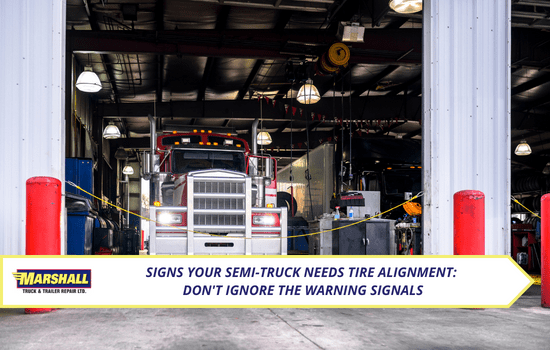Proper tire alignment is vital for the performance, safety, and longevity of your semi-truck. When your truck's tires are misaligned, it can lead to various problems that affect handling, fuel efficiency, and tire wear.
Road to Efficiency: Identifying Tire Alignment Problems in Trucks
 Proper tire alignment is crucial for the performance and safety of your semi-truck. In this blog, we will explore the signs that indicate your truck may need tire alignment. By recognizing these warning signals, you can address alignment issues promptly, ensuring optimal performance and minimizing unnecessary expenses.
Proper tire alignment is crucial for the performance and safety of your semi-truck. In this blog, we will explore the signs that indicate your truck may need tire alignment. By recognizing these warning signals, you can address alignment issues promptly, ensuring optimal performance and minimizing unnecessary expenses.
Irregular or Uneven Tire Wear:
One of the most apparent signs of tire misalignment is irregular or uneven tire wear. If you notice excessive wear on the inner or outer edges of your truck's tires, it suggests an alignment problem. Cupping, scalloping, feathering, or tread wear patterns that differ significantly between tires are indicators that alignment adjustments are needed.
Read more about The Correlation of Tractor-Trailer Alignment and Tire Wear here.
Truck Pulling to One Side:
When driving on a straight, level road, your semi-truck should move in a straight line without pulling to one side. If you find yourself constantly correcting the steering to maintain a straight course, it may be due to tire misalignment. This pulling sensation indicates that your truck's wheels are not aligned properly and require adjustment.
Steering Wheel Off-Center:
An off-centre steering wheel is another indication of misalignment. When the wheels are properly aligned, the steering wheel should be straight and centred. If you notice that your steering wheel is consistently turned to one side while driving straight, it is likely a sign of alignment issues.
Vibrations or Shaking:
Misaligned tires can result in vibrations or shaking felt through the steering wheel or the entire vehicle. This can occur at various speeds and may indicate a need for tire alignment. Vibrations can also be a sign of other underlying issues, so it's essential to have your truck inspected by a professional to determine the exact cause.
Excessive Tire Wear on Drive or Trailer Axles:
Pay attention to the specific axles experiencing excessive tire wear. Misalignment often affects either the drive axles or the trailer axles more prominently. If you consistently observe abnormal tire wear patterns on a specific axle, it's a clear indication that alignment adjustments are necessary.
Reduced Fuel Efficiency:
Tire misalignment can impact fuel efficiency. When the wheels are not aligned correctly, the truck experiences increased rolling resistance, requiring more power and fuel consumption to maintain speed. If you notice a sudden decrease in fuel efficiency without any other apparent causes, consider getting your tires and alignment checked.
Recent Events:
Certain events can throw your semi-truck alignment out of spec, such as hitting a curb, driving over rough terrain, or encountering potholes. If you've experienced any of these incidents recently, it's important to have your alignment inspected, even if you haven't noticed any immediate signs of misalignment.
Pay attention to the signs indicating misalignment, including irregular tire wear, the truck pulling to one side, an off-centre steering wheel, vibrations, excessive wear on specific axles, reduced fuel efficiency, and recent events that may have affected alignment. If you’re experiencing this, it would be best to speak with your specialized truck mechanic today.
